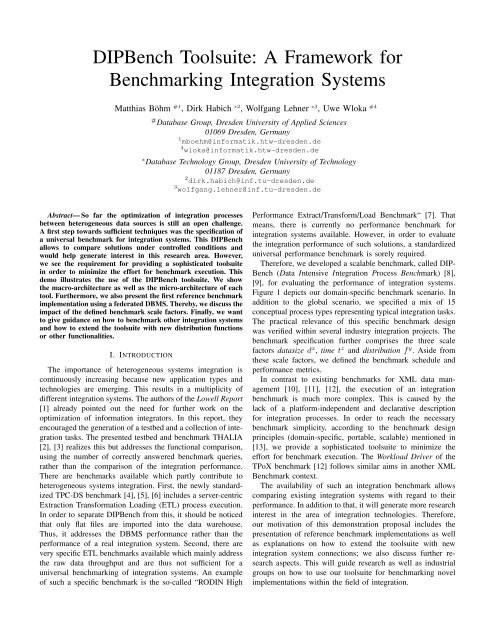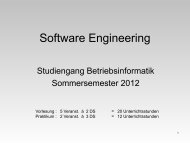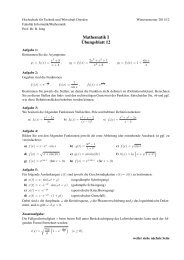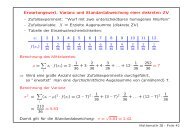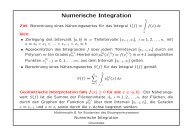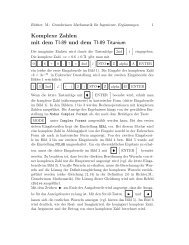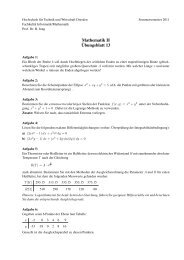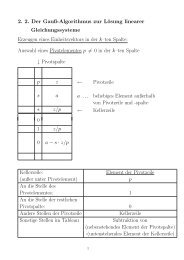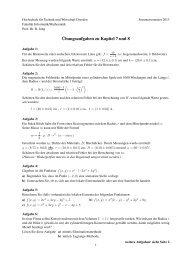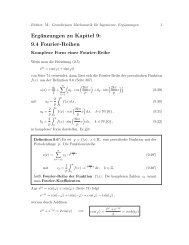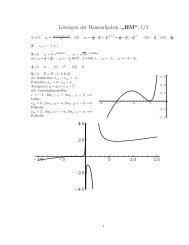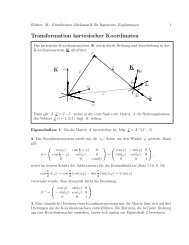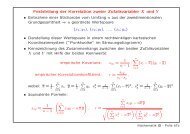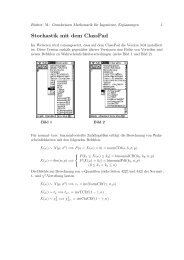DIPBench Toolsuite: A Framework for Benchmarking Integration Systems
DIPBench Toolsuite: A Framework for Benchmarking Integration Systems
DIPBench Toolsuite: A Framework for Benchmarking Integration Systems
You also want an ePaper? Increase the reach of your titles
YUMPU automatically turns print PDFs into web optimized ePapers that Google loves.
<strong>DIPBench</strong> <strong>Toolsuite</strong>: A <strong>Framework</strong> <strong>for</strong><br />
<strong>Benchmarking</strong> <strong>Integration</strong> <strong>Systems</strong><br />
Matthias Böhm #1 , Dirk Habich ∗2 , Wolfgang Lehner ∗3 , Uwe Wloka #4<br />
Abstract— So far the optimization of integration processes<br />
between heterogeneous data sources is still an open challenge.<br />
A first step towards sufficient techniques was the specification of<br />
a universal benchmark <strong>for</strong> integration systems. This <strong>DIPBench</strong><br />
allows to compare solutions under controlled conditions and<br />
would help generate interest in this research area. However,<br />
we see the requirement <strong>for</strong> providing a sophisticated toolsuite<br />
in order to minimize the ef<strong>for</strong>t <strong>for</strong> benchmark execution. This<br />
demo illustrates the use of the <strong>DIPBench</strong> toolsuite. We show<br />
the macro-architecture as well as the micro-architecture of each<br />
tool. Furthermore, we also present the first reference benchmark<br />
implementation using a federated DBMS. Thereby, we discuss the<br />
impact of the defined benchmark scale factors. Finally, we want<br />
to give guidance on how to benchmark other integration systems<br />
and how to extend the toolsuite with new distribution functions<br />
or other functionalities.<br />
I. INTRODUCTION<br />
The importance of heterogeneous systems integration is<br />
continuously increasing because new application types and<br />
technologies are emerging. This results in a multiplicity of<br />
different integration systems. The authors of the Lowell Report<br />
[1] already pointed out the need <strong>for</strong> further work on the<br />
optimization of in<strong>for</strong>mation integrators. In this report, they<br />
encouraged the generation of a testbed and a collection of integration<br />
tasks. The presented testbed and benchmark THALIA<br />
[2], [3] realizes this but addresses the functional comparison,<br />
using the number of correctly answered benchmark queries,<br />
rather than the comparison of the integration per<strong>for</strong>mance.<br />
There are benchmarks available which partly contribute to<br />
heterogeneous systems integration. First, the newly standardized<br />
TPC-DS benchmark [4], [5], [6] includes a server-centric<br />
Extraction Trans<strong>for</strong>mation Loading (ETL) process execution.<br />
In order to separate <strong>DIPBench</strong> from this, it should be noticed<br />
that only flat files are imported into the data warehouse.<br />
Thus, it addresses the DBMS per<strong>for</strong>mance rather than the<br />
per<strong>for</strong>mance of a real integration system. Second, there are<br />
very specific ETL benchmarks available which mainly address<br />
the raw data throughput and are thus not sufficient <strong>for</strong> a<br />
universal benchmarking of integration systems. An example<br />
of such a specific benchmark is the so-called “RODIN High<br />
# Database Group, Dresden University of Applied Sciences<br />
01069 Dresden, Germany<br />
1 mboehm@in<strong>for</strong>matik.htw-dresden.de<br />
4 wloka@in<strong>for</strong>matik.htw-dresden.de<br />
∗ Database Technology Group, Dresden University of Technology<br />
01187 Dresden, Germany<br />
2 dirk.habich@inf.tu-dresden.de<br />
3 wolfgang.lehner@inf.tu-dresden.de<br />
Per<strong>for</strong>mance Extract/Trans<strong>for</strong>m/Load Benchmark“ [7]. That<br />
means, there is currently no per<strong>for</strong>mance benchmark <strong>for</strong><br />
integration systems available. However, in order to evaluate<br />
the integration per<strong>for</strong>mance of such solutions, a standardized<br />
universal per<strong>for</strong>mance benchmark is sorely required.<br />
There<strong>for</strong>e, we developed a scalable benchmark, called DIP-<br />
Bench (Data Intensive <strong>Integration</strong> Process Benchmark) [8],<br />
[9], <strong>for</strong> evaluating the per<strong>for</strong>mance of integration systems.<br />
Figure 1 depicts our domain-specific benchmark scenario. In<br />
addition to the global scenario, we specified a mix of 15<br />
conceptual process types representing typical integration tasks.<br />
The practical relevance of this specific benchmark design<br />
was verified within several industry integration projects. The<br />
benchmark specification further comprises the three scale<br />
factors datasize d x , time t z and distribution f y . Aside from<br />
these scale factors, we defined the benchmark schedule and<br />
per<strong>for</strong>mance metrics.<br />
In contrast to existing benchmarks <strong>for</strong> XML data management<br />
[10], [11], [12], the execution of an integration<br />
benchmark is much more complex. This is caused by the<br />
lack of a plat<strong>for</strong>m-independent and declarative description<br />
<strong>for</strong> integration processes. In order to reach the necessary<br />
benchmark simplicity, according to the benchmark design<br />
principles (domain-specific, portable, scalable) mentioned in<br />
[13], we provide a sophisticated toolsuite to minimize the<br />
ef<strong>for</strong>t <strong>for</strong> benchmark execution. The Workload Driver of the<br />
TPoX benchmark [12] follows similar aims in another XML<br />
Benchmark context.<br />
The availability of such an integration benchmark allows<br />
comparing existing integration systems with regard to their<br />
per<strong>for</strong>mance. In addition to that, it will generate more research<br />
interest in the area of integration technologies. There<strong>for</strong>e,<br />
our motivation of this demonstration proposal includes the<br />
presentation of reference benchmark implementations as well<br />
as explanations on how to extend the toolsuite with new<br />
integration system connections; we also discuss further research<br />
aspects. This will guide research as well as industrial<br />
groups on how to use our toolsuite <strong>for</strong> benchmarking novel<br />
implementations within the field of integration.
Fig. 1. <strong>DIPBench</strong> ETL Scenario<br />
Our <strong>DIPBench</strong> specification of an integration benchmark<br />
and the presentation of the correlated toolsuite are first steps<br />
towards more extensive research on optimization techniques in<br />
the context of integration processes. So, the significance of the<br />
contribution is based on the preparation of preconditions <strong>for</strong><br />
integration system comparison and further research on in<strong>for</strong>mation<br />
integration optimization techniques. The contribution<br />
mainly consists of two parts: first, the conceptual discussion<br />
of the novel <strong>DIPBench</strong> benchmark specification and second,<br />
the presentation and explanation of the related toolsuite.<br />
The remainder of the paper is structured as follows: In the<br />
following section, we give a short overview of our benchmark<br />
including the general benchmark scenario, the process type<br />
groups, as well as the specified scale factors. In Section<br />
3, we discuss the <strong>DIPBench</strong> toolsuite architecture in detail,<br />
including its macro- and micro-architecture. Demonstration<br />
details are described in Section 4. Finally, the paper closes<br />
with a conclusion and future work.<br />
II. DIPBENCH OVERVIEW<br />
The technical context of the <strong>DIPBench</strong> comprises different<br />
types of integration tasks, which are typical <strong>for</strong> physical<br />
integration processes within an ETL environment. This benchmark<br />
addresses data manipulating integration systems rather<br />
than read-only in<strong>for</strong>mation systems. In contrast to functional<br />
integration benchmarks, we focus on a real-life scenario rather<br />
than comprising all possible types of syntactic and semantic<br />
heterogeneities. The benchmark scenario, illustrated in Figure<br />
1, is divided into four layers, and different process types<br />
are specified <strong>for</strong> each layer.<br />
• Layer A - Source System Management: The first layer<br />
represents all regionally separated source systems, including<br />
applications, Web services and different RDBMS.<br />
Further, three integration tasks are specified.<br />
• Layer B - Data Consolidation: The second logical layer<br />
consists of a consolidated database (CDB). It represents<br />
the staging area of the whole ETL benchmark scenario.<br />
Basically, seven different integration tasks between the<br />
source systems and the CDB are defined.<br />
• Layer C - Data Warehouse Update: Layer three represents<br />
the actual data warehouse (DWH) system. Only<br />
clean and consolidated data is loaded into this system,<br />
based on a defined time schedule. We have defined two<br />
integration processes between the CDB and the DWH.<br />
• Layer D - Data Mart Update: In order to realize physical<br />
optimizations, workload reduction as well as a locationbased<br />
partitioning, the fourth layer comprises three independent<br />
data marts. So, there are also 2 integration<br />
processes between the DWH and the data marts.<br />
The internal processing of the whole benchmark will be<br />
influenced by the three scale factors datasize (d x ), time (t z )<br />
and distribution (f y ). The continuous scale factor datasize<br />
(d x ) allows <strong>for</strong> scaling the amount of data to be integrated.<br />
Thus, the dataset size of the external systems, and in some<br />
cases the number of process instances, depends on it. The<br />
continuous scale factor time (t z ) allows the scaling of time<br />
intervals between process-initiating events by influencing the<br />
benchmark scheduling. Moreover, the scale factor time has an<br />
impact on the degree of concurrency. The discrete scale factor<br />
distribution (f y ) is used to provide different data characteristics<br />
from uni<strong>for</strong>mly distributed data values to specially skewed<br />
data values.<br />
III. DIPBENCH TOOLSUITE ARCHITECTURE<br />
In this section, we describe the architecture of our developed<br />
<strong>DIPBench</strong> toolsuite. First, we present the overall<br />
macro-architecture and its position within the whole benchmark<br />
execution environment. Second, we describe the microarchitecture<br />
of the demonstrated tools in short. Figure 2 illustrates<br />
the mentioned macro-architecture. Fundamentally, the<br />
tools Client, Initializer and Monitor are provided.<br />
These tools, which were implemented in Java and are thus<br />
plat<strong>for</strong>m-independent, could be accessed using an API or via<br />
a developed GUI. The benchmark execution runtime comprises<br />
one computer system <strong>for</strong> all external source and target systems<br />
and one computer system <strong>for</strong> the actual integration system.<br />
Fig. 2. <strong>Toolsuite</strong> Macro-Architecture
Fig. 3. Client Micro-Architecture<br />
In the following, we want to discuss the architecture of the<br />
single tools and point out solved challenges and problems.<br />
Figure 3 shows the micro-architecture of the Client tool,<br />
which is used <strong>for</strong> scheduling integration processes. Thereby,<br />
it handles the connections to the integration system (system<br />
under test). From an abstract point of view, this tool is<br />
comparable to the TPoX [12] Workload Driver. The tool could<br />
be accessed using the well defined interface IClient. The<br />
Scheduler initializes and manages the execution of the four<br />
Scheduled Streams, which are in fact multi-threaded<br />
event streams. If an event occurs, the ConnectionFactory<br />
is used to invoke the integration system in a generic manner.<br />
Thus, <strong>for</strong> benchmarking one’s own system prototype, only one<br />
such connection—inherited from AISConnection—has to<br />
be provided and registered at the ConnectionFactory.<br />
In order to reach a sufficient number of statistics, the<br />
benchmark execution phase comprises 100 benchmark periods.<br />
After each period, the external systems have to be reinitialized.<br />
The Client uses the Initializer tool, whose architecture<br />
is shown in Figure 4. This tool allows schema creation<br />
and universal data initialization <strong>for</strong> relational data sources<br />
as well as XML-based systems. In analogy to the Client,<br />
this tool realizes the IInitializer interface. Basically, the<br />
schemas are specified with TableMetadata objects. These<br />
gen<br />
Cardinality<br />
Table<br />
Scale<br />
Table<br />
Initializer DAO<br />
(Data Access Object)<br />
DataGenerator<br />
Thread Pool<br />
ADistribution<br />
Function<br />
DFUni<strong>for</strong>m<br />
DFNormal<br />
DFPoisson<br />
DFLogNormal<br />
DFPareto<br />
CSV<br />
Connection<br />
JDBC<br />
Connection<br />
IInitializer<br />
DIP Initializer<br />
tuple<br />
streams<br />
conn<br />
XML<br />
Connection<br />
Fig. 4. Initializer Micro-Architecture<br />
Tool<br />
Factory<br />
Table<br />
Metadata<br />
Foreignkey<br />
Domain<br />
IDBucket<br />
Constraints<br />
Plat<strong>for</strong>m<br />
meta<br />
Fig. 5. Monitor Micro-Architecture<br />
metadata objects also refer to <strong>for</strong>eign-key specifications, value<br />
domains, special IDBuckets and several types of constraint<br />
specifications. With these definitions, e.g., ranges of numbers<br />
could be applied <strong>for</strong> the different external systems but also<br />
single-column, multi-column, multi-table constraints can be<br />
specified. Furthermore, this tool allows multi-threaded data<br />
generation. The metadata objects are passed to the specific<br />
Data Generator and the generated tuples are directly put<br />
out into special tuplestreams. The aligned data connection<br />
could start to insert tuples while the data generation is not yet<br />
finished. By limiting the tuplestream to a maximum number<br />
of buffered tuples, the generation is realized with awareness<br />
of main memory restrictions. The very generic separation of<br />
the different data distribution functions and data connections<br />
makes it easy to extend the given tool. However, the current<br />
version even supports the specification of data properties<br />
(average, variance, skewness and null-values). Note that the<br />
cardinalities can be specified with the scale factor datasize as<br />
well as with the ScaleTable in order to separate linear and<br />
sub-linear scaling tables.<br />
The Monitor tool is used by the Client and allows<br />
collecting, analyzing and plotting per<strong>for</strong>mance statistics. Figure<br />
5 shows its micro-architecture, which is quite similar<br />
to the architecture of the already described tools. Thus,<br />
it implements the interface IMonitor. The core System<br />
Monitor comprises an Event Buffer where per<strong>for</strong>mance<br />
events are collected. These events are represented by a data<br />
structure, which includes the event ID (EID), the process<br />
type ID (PTID), the start time (T0) and the end time (T1).<br />
The whole Event Buffer is incrementally flushed to disk<br />
during benchmark execution. After the benchmark execution<br />
has been finished, the whole statistics are loaded and analyzed<br />
by the Statistics Analyzer. The result of this analysis<br />
is represented by the specific per<strong>for</strong>mance metrics [8] <strong>for</strong><br />
each process type ID. In this area, a major challenge was the<br />
cost normalization. Finally, these results are flushed to disk<br />
in order to generate a per<strong>for</strong>mance plot with the Diagram<br />
Plotter using the jgnuplot library [14]. One might judge the<br />
event management as per<strong>for</strong>mance bottleneck. However, due<br />
to the fact that there are no side effects between the measured<br />
per<strong>for</strong>mance metric and the management of events, this can<br />
be disregarded.
IV. DEMONSTRATION DETAILS<br />
After the presentation of the <strong>DIPBench</strong> toolsuite and its<br />
architecture, we use this section to outline features we would<br />
like to present at ICDE. In general, the demonstration features<br />
can be classified into seven aspects.<br />
General <strong>Toolsuite</strong> Presentation: First, we want to demonstrate<br />
the usage of the toolsuite by presenting the graphical<br />
user interface and explaining the provided API. Furthermore,<br />
configuration parameters and the benchmark setup are discussed<br />
in general. Second, this abstract presentation is used<br />
to illustrate the general <strong>DIPBench</strong> approach and to discuss<br />
benchmark-related aspects.<br />
Data Generator Explanation: Considering the aspect of<br />
data generation, we will demonstrate the impact of our different<br />
data distribution functions. Especially the poisson distribution<br />
function—which allows different types of skewed data—<br />
will be explained in detail. Furthermore, we will demonstrate<br />
the different correlation types one-column, between columns<br />
of one table and between columns of multiple tables.<br />
Reference Implementation Illustration: Further in-depth<br />
aspects are reference implementations <strong>for</strong> federated DBMS, an<br />
ETL tool, a subscription system as well as a WSBPEL process<br />
engine. First, the reference implementations are demonstrated.<br />
Second, implementation aspects and optimization possibilities<br />
are also discussed.<br />
Scale Factor Impact Demonstration: After we have shown<br />
the GUI facilities <strong>for</strong> specifying the scale factor values,<br />
we demonstrate their impact using the mentioned reference<br />
implementations. So, <strong>for</strong> example, we show the impact of the<br />
scale factors datasize d x , time t z and distribution f y .<br />
Data Generator Implementation Guidance: As already<br />
mentioned, the Initializer tool could be extended with<br />
new data generators. This could be useful if new data distribution<br />
functions are needed or if special correlations should<br />
be implemented. So, we will use the demo to give guidance<br />
on how to extend the toolsuite with such data generators.<br />
Benchmark Implementation Guidance: The Client tool<br />
could be extended with new integration system connections.<br />
This is necessary in order to realize a benchmark implementation.<br />
Thus, this is the extension point where research groups<br />
have to customize the toolsuite in order to benchmark their<br />
own system. With the intent of minimizing the ef<strong>for</strong>t of such<br />
customization tasks, we will give guidance on how to integrate<br />
their own connections.<br />
Benchmark Discussion: Since we believe in the importance<br />
of such a benchmark, we would like to discuss open issues<br />
and challenges related to this benchmark. Further, we see some<br />
potential <strong>for</strong> more challenging integration tasks, including all<br />
types of syntactic and semantic heterogeneities. So, in the<br />
end, there is room to discuss future versions of the <strong>DIPBench</strong><br />
specification and further research aspects like the model-driven<br />
generation and optimization of integration processes.<br />
To summarize, the demo at ICDE comprises an in-depth<br />
explanation of all necessary aspects of our benchmark, including<br />
its reference implementations. Furthermore, visitors of our<br />
demonstration desk will get a more in-depth understanding of<br />
the benchmark and its further application areas.<br />
V. SUMMARY AND FUTURE WORK<br />
We specified the <strong>DIPBench</strong> benchmark, because of the<br />
absence of an independent per<strong>for</strong>mance benchmark <strong>for</strong> dataintensive<br />
integration processes. In order to reach the highest<br />
possible simplicity within this complex context of integration<br />
processes, there was the need <strong>for</strong> the provision of a<br />
sophisticated toolsuite to minimize the ef<strong>for</strong>t necessary <strong>for</strong><br />
new benchmark implementations. In this paper, we presented<br />
the <strong>DIPBench</strong> toolsuite, which could be used as a framework<br />
<strong>for</strong> benchmark integration systems. Thereby, the core<br />
toolsuite comprises three tools: Client, Initializer and<br />
Monitor. In addition to this, the number of adjusting screws<br />
within the toolsuite causes the significance of the demo. Thus,<br />
it is highly recommended to demonstrate and discuss the<br />
impact of special configurations but also to explain how one’s<br />
own benchmark implementations could be realized with minimal<br />
ef<strong>for</strong>t. Finally, we want to use the demonstration program<br />
as a <strong>for</strong>um <strong>for</strong> discussing the benchmark specification.<br />
ACKNOWLEDGMENT<br />
We want to thank the students Katrin Braunschweig, Romain<br />
Treboux and Dirk Alsfaßer <strong>for</strong> their ef<strong>for</strong>ts on extending<br />
and enhancing the Initializer tool.<br />
REFERENCES<br />
[1] S. Abiteboul, R. Agrawal, P. A. Bernstein, M. J. Carey, S. Ceri, W. B.<br />
Croft, D. J. DeWitt, M. J. Franklin, H. Garcia-Molina, D. Gawlick,<br />
J. Gray, L. M. Haas, A. Y. Halevy, J. M. Hellerstein, Y. E. Ioannidis,<br />
M. L. Kersten, M. J. Pazzani, M. Lesk, D. Maier, J. F. Naughton, H.-J.<br />
Schek, T. K. Sellis, A. Silberschatz, M. Stonebraker, R. T. Snodgrass,<br />
J. D. Ullman, G. Weikum, J. Widom, and S. B. Zdonik, “The lowell<br />
database research self assessment,” CoRR, vol. cs.DB/0310006, 2003.<br />
[2] J. Hammer, M. Stonebraker, and O. Topsakal, “Thalia : Test harness <strong>for</strong><br />
the assessment of legacy in<strong>for</strong>mation integration approaches,” University<br />
of Florida,” Technical Report, 2005.<br />
[3] ——, “Thalia: Test harness <strong>for</strong> the assessment of legacy in<strong>for</strong>mation<br />
integration approaches.” in ICDE, 2005, pp. 485–486.<br />
[4] R. Othayoth and M. Poess, “The making of tpc-ds.” in VLDB, 2006, pp.<br />
1049–1058.<br />
[5] M. Pöss, B. Smith, L. Kollár, and P.- ˚A. Larson, “Tpc-ds, taking decision<br />
support benchmarking to the next level.” in SIGMOD Conference, 2002,<br />
pp. 582–587.<br />
[6] TPC-DS - ad-hoc, decision support benchmark, Transaction Processing<br />
Per<strong>for</strong>mance Council, 2007.<br />
[7] High Per<strong>for</strong>mance Extract/Trans<strong>for</strong>m/Load Benchmark, RODIN Data<br />
Asset Management, 2002.<br />
[8] M. Böhm, D. Habich, W. Lehner, and U. Wloka, “Dipbench: An independent<br />
benchmark <strong>for</strong> data intensive integration processes,” Dresden<br />
University of Applied Sciences,” Technical Report, 2007.<br />
[9] <strong>DIPBench</strong>, Dresden University of Technology, Database Technology<br />
Group, http://wwwdb.inf.tu-dresden.de/research/gcip/, 2007.<br />
[10] T. Böhme and E. Rahm, “Xmach-1: A benchmark <strong>for</strong> xml data management.”<br />
in BTW, 2001, pp. 264–273.<br />
[11] ——, “Multi-user evaluation of xml data management systems with<br />
xmach-1.” in EEXTT, 2002, pp. 148–158.<br />
[12] M. Nicola, I. Kogan, and B. Schiefer, “An xml transaction processing<br />
benchmark.” in SIGMOD Conference, 2007, pp. 937–948.<br />
[13] J. Gray and A. Reuter, Transaction Processing : Concepts<br />
and Techniques (Morgan Kaufmann Series in Data Management<br />
<strong>Systems</strong>). Morgan Kaufmann, October 1992. [Online]. Available:<br />
http://www.amazon.de/exec/obidos/ASIN/1558601902<br />
[14] java library <strong>for</strong> interfacing with the gnuplot plotting package, jgnuplot<br />
project, http://jgnuplot.source<strong>for</strong>ge.net/, 2007.


